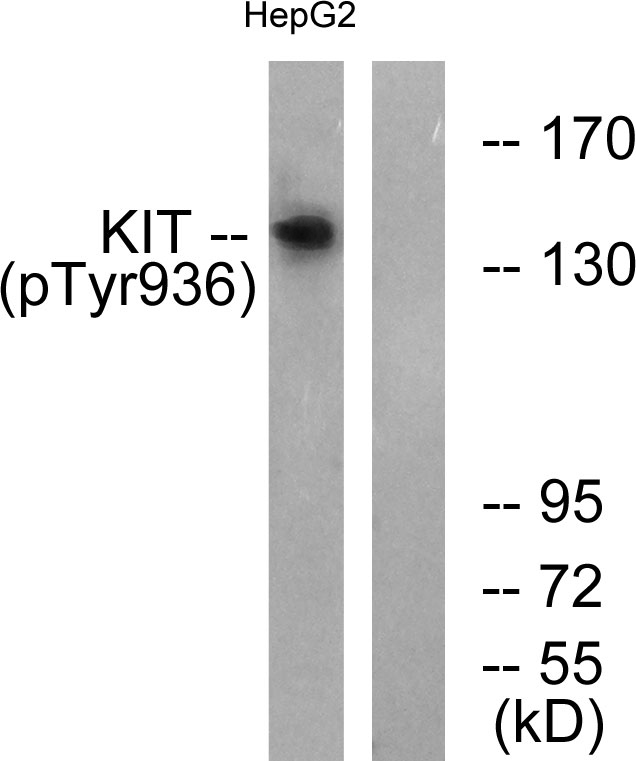c-Kit (phospho Tyr936) Polyclonal Antibody
- Catalog No.:YP0657
- Applications:WB;IHC;IF;ELISA
- Reactivity:Human;Mouse
- Target:
- c-Kit/CD117
- Fields:
- >>MAPK signaling pathway;>>Ras signaling pathway;>>Rap1 signaling pathway;>>Phospholipase D signaling pathway;>>PI3K-Akt signaling pathway;>>Hematopoietic cell lineage;>>Melanogenesis;>>Pathways in cancer;>>Acute myeloid leukemia;>>Breast cancer;>>Central carbon metabolism in cancer
- Gene Name:
- KIT
- Protein Name:
- Mast/stem cell growth factor receptor Kit
- Human Gene Id:
- 3815
- Human Swiss Prot No:
- P10721
- Mouse Gene Id:
- 16590
- Mouse Swiss Prot No:
- P05532
- Immunogen:
- The antiserum was produced against synthesized peptide derived from human KIT around the phosphorylation site of Tyr936. AA range:906-955
- Specificity:
- Phospho-c-Kit (Y936) Polyclonal Antibody detects endogenous levels of c-Kit protein only when phosphorylated at Y936.
- Formulation:
- Liquid in PBS containing 50% glycerol, 0.5% BSA and 0.02% sodium azide.
- Source:
- Polyclonal, Rabbit,IgG
- Dilution:
- WB 1:500 - 1:2000. IHC 1:100 - 1:300. ELISA: 1:5000.. IF 1:50-200
- Purification:
- The antibody was affinity-purified from rabbit antiserum by affinity-chromatography using epitope-specific immunogen.
- Concentration:
- 1 mg/ml
- Storage Stability:
- -15°C to -25°C/1 year(Do not lower than -25°C)
- Other Name:
- KIT;SCFR;Mast/stem cell growth factor receptor Kit;SCFR;Piebald trait protein;PBT;Proto-oncogene c-Kit;Tyrosine-protein kinase Kit;p145 c-kit;v-kit Hardy-Zuckerman 4 feline sarcoma viral oncogene homolog;CD antigen CD117
- Observed Band(KD):
- 145kD
- Background:
- This gene encodes the human homolog of the proto-oncogene c-kit. C-kit was first identified as the cellular homolog of the feline sarcoma viral oncogene v-kit. This protein is a type 3 transmembrane receptor for MGF (mast cell growth factor, also known as stem cell factor). Mutations in this gene are associated with gastrointestinal stromal tumors, mast cell disease, acute myelogenous lukemia, and piebaldism. Multiple transcript variants encoding different isoforms have been found for this gene. [provided by RefSeq, Jul 2008],
- Function:
- catalytic activity:ATP + a [protein]-L-tyrosine = ADP + a [protein]-L-tyrosine phosphate.,disease:Defects in KIT are a cause of gastrointestinal stromal tumor (GIST) [MIM:606764].,disease:Defects in KIT are a cause of piebaldism [MIM:172800]. Piebaldism is an autosomal dominant genetic developmental abnormality of pigmentation characterized by congenital patches of white skin and hair that lack melanocytes.,disease:Defects in KIT have been associated with testicular tumors [MIM:273300]. It includes germ cell tumor (GCT) or testicular germ cell tumor (TGCT).,function:This is the receptor for stem cell factor (mast cell growth factor). It has a tyrosine-protein kinase activity. Binding of the ligands leads to the autophosphorylation of KIT and its association with substrates such as phosphatidylinositol 3-kinase (Pi3K).,online information:CD117 entry,similarity:Belongs to the protein kinas
- Subcellular Location:
- [Isoform 1]: Cell membrane; Single-pass type I membrane protein.; [Isoform 2]: Cell membrane; Single-pass type I membrane protein.; [Isoform 3]: Cytoplasm . Detected in the cytoplasm of spermatozoa, especially in the equatorial and subacrosomal region of the sperm head. .
- Expression:
- [Isoform 3]: In testis, detected in spermatogonia in the basal layer and in interstitial Leydig cells but not in Sertoli cells or spermatocytes inside the seminiferous tubules (at protein level) (PubMed:20601678). Expression is maintained in ejaculated spermatozoa (at protein level) (PubMed:20601678).
- June 19-2018
- WESTERN IMMUNOBLOTTING PROTOCOL
- June 19-2018
- IMMUNOHISTOCHEMISTRY-PARAFFIN PROTOCOL
- June 19-2018
- IMMUNOFLUORESCENCE PROTOCOL
- September 08-2020
- FLOW-CYTOMEYRT-PROTOCOL
- May 20-2022
- Cell-Based ELISA│解您多样本WB检测之困扰
- July 13-2018
- CELL-BASED-ELISA-PROTOCOL-FOR-ACETYL-PROTEIN
- July 13-2018
- CELL-BASED-ELISA-PROTOCOL-FOR-PHOSPHO-PROTEIN
- July 13-2018
- Antibody-FAQs
- Products Images

- Immunohistochemical analysis of paraffin-embedded Human brain. Antibody was diluted at 1:100(4° overnight). High-pressure and temperature Tris-EDTA,pH8.0 was used for antigen retrieval. Negetive contrl (right) obtaned from antibody was pre-absorbed by immunogen peptide.

- Immunohistochemistry analysis of paraffin-embedded human heart, using KIT (Phospho-Tyr936) Antibody. The picture on the right is blocked with the phospho peptide.

- Western blot analysis of lysates from HepG2 cells treated with EGF 200ng/ml 30', using KIT (Phospho-Tyr936) Antibody. The lane on the right is blocked with the phospho peptide.



